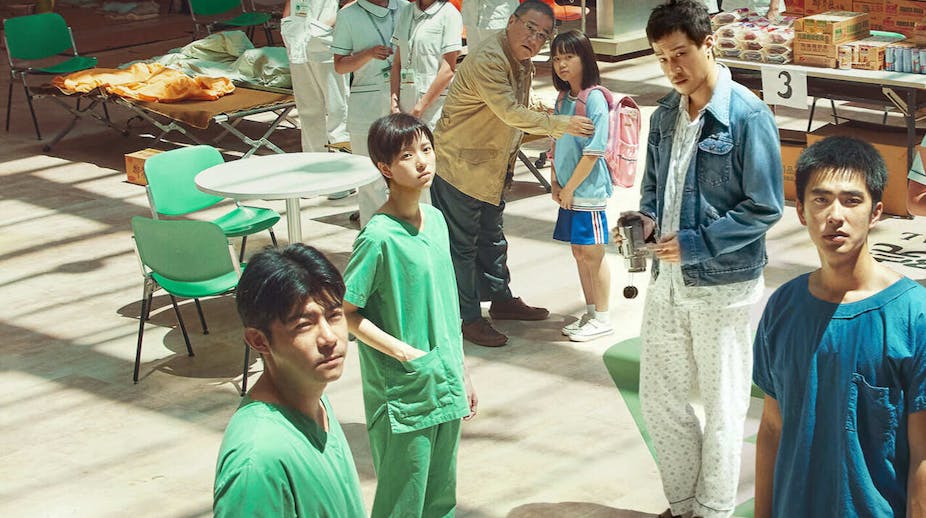Netflix’s Taiwanese drama, Eye of the Storm, is the latest cinematic depiction of a pandemic. But rather than focus on COVID, it tells the story of the 2003 Sars epidemic through Taipei City Hospital’s Heping branch. This real event, where a devastating outbreak led to the hospital’s lockdown, serves as the film’s backdrop.
While the eye in a storm is often deceptively calm, this hospital is chaotic. Drawing inspiration from previous medical thrillers like Contagion (2011), Eye of the Storm has all the tropes of a medical drama. But the story is also peppered with melodramatic nuances, creating what I call a “medical melodrama”.
At its core is Dr Xia Zheng (Po-Chieh Wang), an accomplished but self-absorbed surgeon who unexpectedly finds himself trapped within the confines of the quarantined hospital. A noble male nurse, An Taihe (Tseng Jing Hua) and empathic surgical intern, Dr Li Xinyan (Chloe Xiang) offer contrast with his character.
Adding another dimension to the story is Jin Youzhong (Simon Hsueh), a tabloid journalist with an insatiable appetite for an explosive story on the outbreak. These protagonists represent the diverse spectrum of emotions and responses in the face of pandemic adversity.
Like standard melodramas, the film’s narrative is built around Dr Xia’s transformative journey. From his initial characterisation, driven by personal ambitions and ego, he evolves into a beacon of hope and selflessness.
He altruistically joins forces with Youzhong, the tabloid journalist, in a desperate effort to uncover the identity of patient zero. While this forms the backbone of the story, the subplot – the love relationship between Taihe and Dr Li, disrupted by the former’s infection – intensifies the film’s emotional tension.
Making the medical melodrama
So how does Eye of the Storm’s medical melodrama work? The film exposes viewers to emotional scenes. One striking moment depicts a distraught child pounding on an intensive care unit door, desperate to see her critically ill mother. Later, there’s a heart-wrenching scene in which a couple parts ways atop the hospital roof, amid a torrential downpour.
The film employs a wide range of cinematic techniques to heighten these emotional moments. Most notably, it uses extreme closeups and first-person shots, which are achieved with a shaky, handheld camera. Furthermore, the haunting soundtrack and gruesome depictions of medical procedures sharply emphasise the characters’ physical and psychological turmoil.
These strategies are not purely aesthetic. They help the audience to commemorate their own lost ones and remember the lessons learned in the COVID pandemic.
I believe Eye of the Storm is deliberately melodramatic in order to facilitate catharsis and allow viewers to release repressed emotions. Our everyday, “ordinary” experiences of the pandemic – such as mask wearing, hand sanitising, quarantining, temperature checking and lockdown – are rendered extraordinary through the show’s melodramatic amplification.
Successes and shortcomings
Eye of the Storm isn’t perfect. The dynamics between characters – especially the ties binding Dr Xia and Youzhong, or the romantic connection between Taihe and Dr Li – are hasty and underdeveloped. An obvious example is a head nurse who abruptly shifts from leading a strike to dutifully caring for patients.
The film also concludes with an ambiguous ending, leaving viewers yearning for clarity, especially given its real-life inspirations.
That said, Eye of the Storm is a valuable contribution to the pandemic genre within Chinese cinema. Contrary to films like Chinese Doctors (2021), which leans heavily on hero-worship, Eye of the Storm refreshingly highlights the humanity and vulnerabilities of healthcare workers. This Taiwanese production, in its focus on the internal dilemmas of medical professionals, offers a stark contrast to the overtly propagandist flavour of mainland Chinese films.
At a deeper level, Eye of the Storm is a commentary on press freedom. Through the journalist character, the film recalls the tragic tale of Li Wenliang, the whistleblower of the COVID outbreak in Wuhan, China. His warnings were stifled and he was chastised for spreading misinformation by the government, eventually succumbing to the virus.
The audacity of the film to represent a journalist investigating the origins of an outbreak would be unthinkable within mainland China’s stringent censorship. This distinction doesn’t just create a dramatic arc, but underscores the profound ideological and political divergences within the Chinese-speaking region.

Looking for something good? Cut through the noise with a carefully curated selection of the latest releases, live events and exhibitions, straight to your inbox every fortnight, on Fridays. Sign up here.

